PPMP 20010: Failed Project Analysis of Sydney Opera House Report
VerifiedAdded on 2022/09/27
|21
|5945
|87
Report
AI Summary
This report provides a comprehensive analysis of the Sydney Opera House project, examining its failure as a case study in project management. It delves into the major issues that plagued the project, including design complexities, lack of a designated project manager, and government interference, which led to significant cost and schedule overruns. The report investigates the control systems implemented, assessing their effectiveness in managing scope, cost, and quality. It analyzes the reasons behind the overruns, focusing on the impact of design changes and poor planning. Furthermore, the report evaluates the project execution team, the relationship between overruns and stakeholders, and potential actions that could have led to a more successful outcome. The analysis includes a discussion of the project's history, the initial estimates, and the eventual escalation of costs and delays, offering valuable insights into the complexities of large-scale construction projects and the importance of effective project management practices. The report concludes with lessons learned from the Sydney Opera House project, emphasizing the need for clear objectives, robust control systems, and effective stakeholder management.
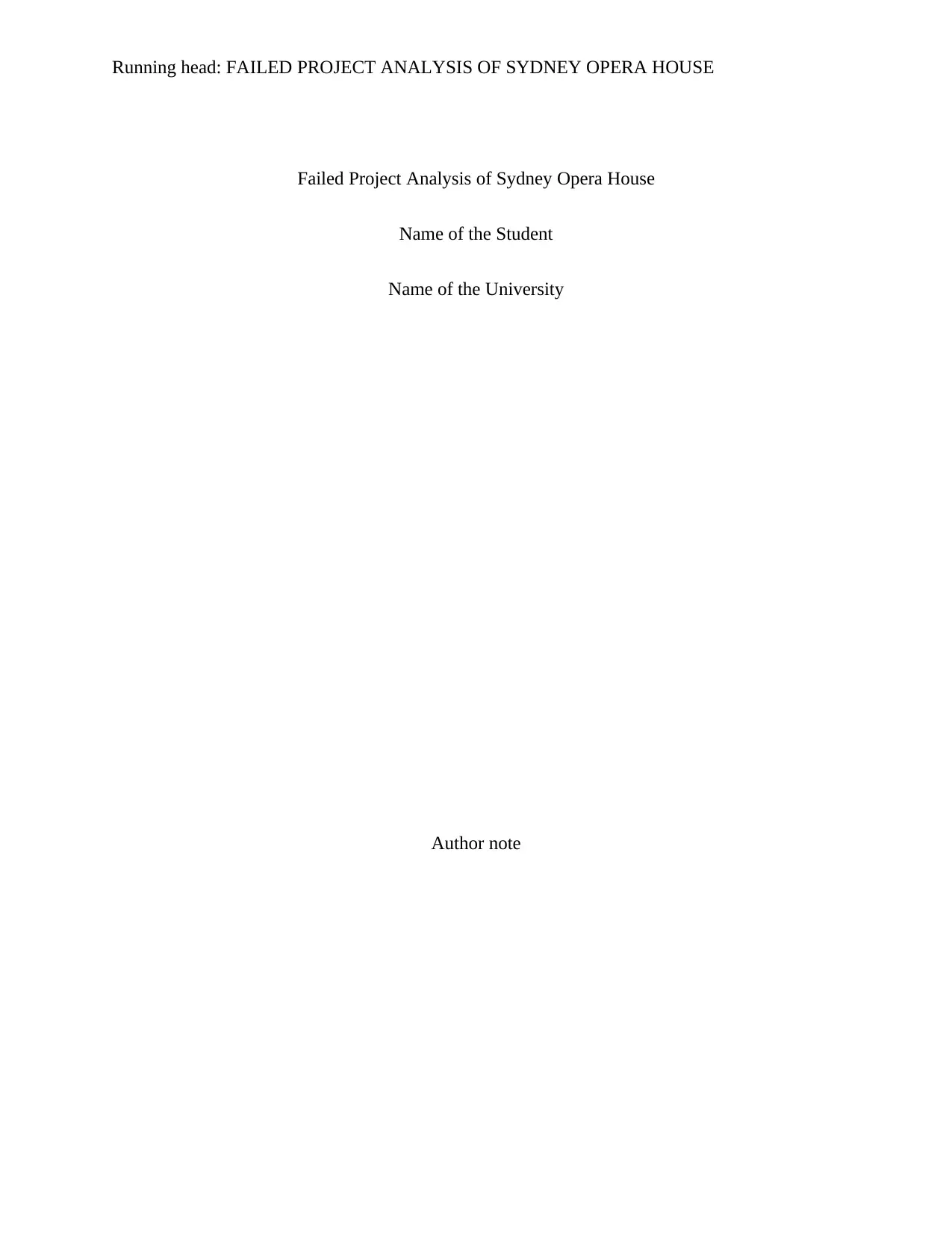
Running head: FAILED PROJECT ANALYSIS OF SYDNEY OPERA HOUSE
Failed Project Analysis of Sydney Opera House
Name of the Student
Name of the University
Author note
Failed Project Analysis of Sydney Opera House
Name of the Student
Name of the University
Author note
Paraphrase This Document
Need a fresh take? Get an instant paraphrase of this document with our AI Paraphraser
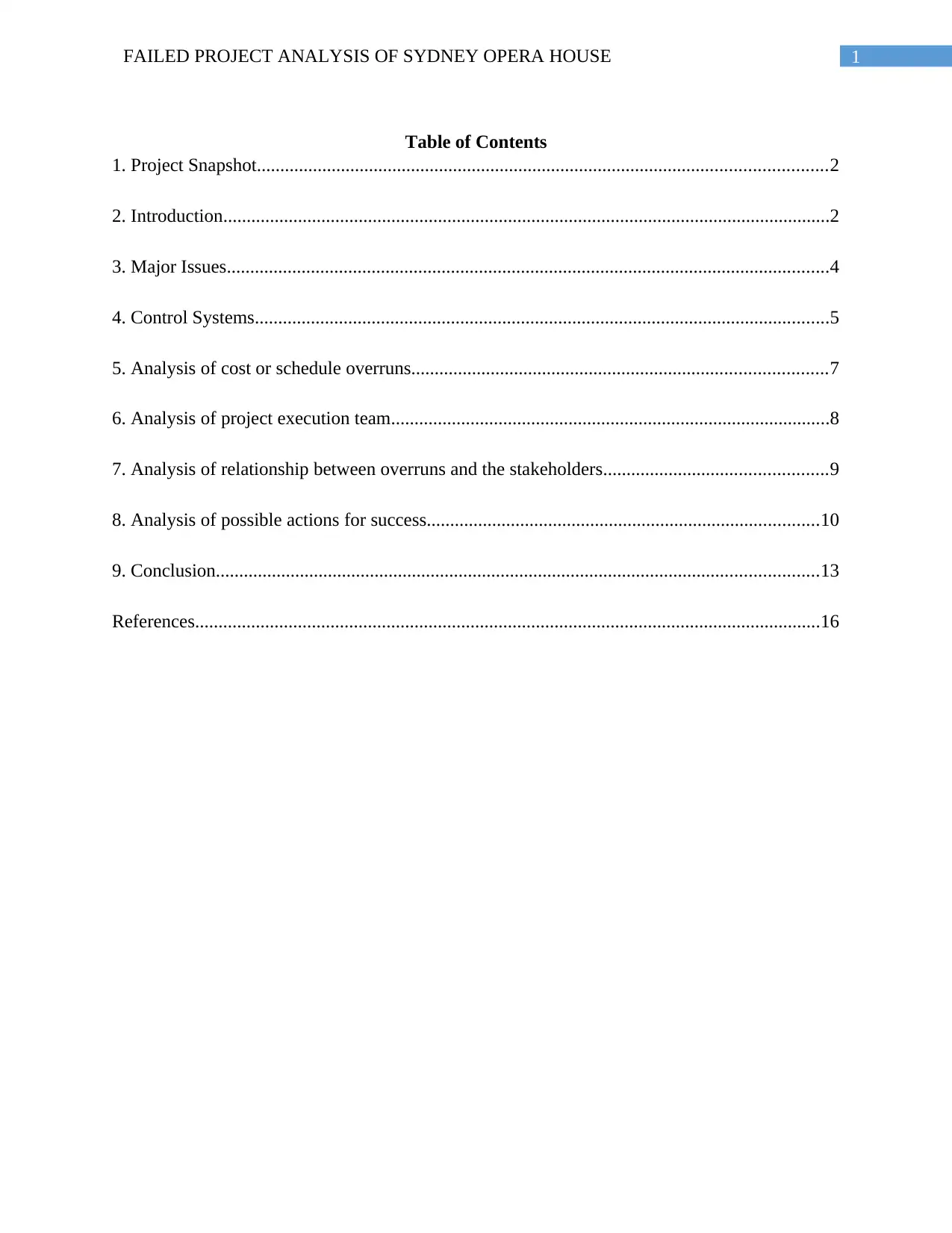
1FAILED PROJECT ANALYSIS OF SYDNEY OPERA HOUSE
Table of Contents
1. Project Snapshot..........................................................................................................................2
2. Introduction..................................................................................................................................2
3. Major Issues.................................................................................................................................4
4. Control Systems...........................................................................................................................5
5. Analysis of cost or schedule overruns.........................................................................................7
6. Analysis of project execution team..............................................................................................8
7. Analysis of relationship between overruns and the stakeholders................................................9
8. Analysis of possible actions for success....................................................................................10
9. Conclusion.................................................................................................................................13
References......................................................................................................................................16
Table of Contents
1. Project Snapshot..........................................................................................................................2
2. Introduction..................................................................................................................................2
3. Major Issues.................................................................................................................................4
4. Control Systems...........................................................................................................................5
5. Analysis of cost or schedule overruns.........................................................................................7
6. Analysis of project execution team..............................................................................................8
7. Analysis of relationship between overruns and the stakeholders................................................9
8. Analysis of possible actions for success....................................................................................10
9. Conclusion.................................................................................................................................13
References......................................................................................................................................16
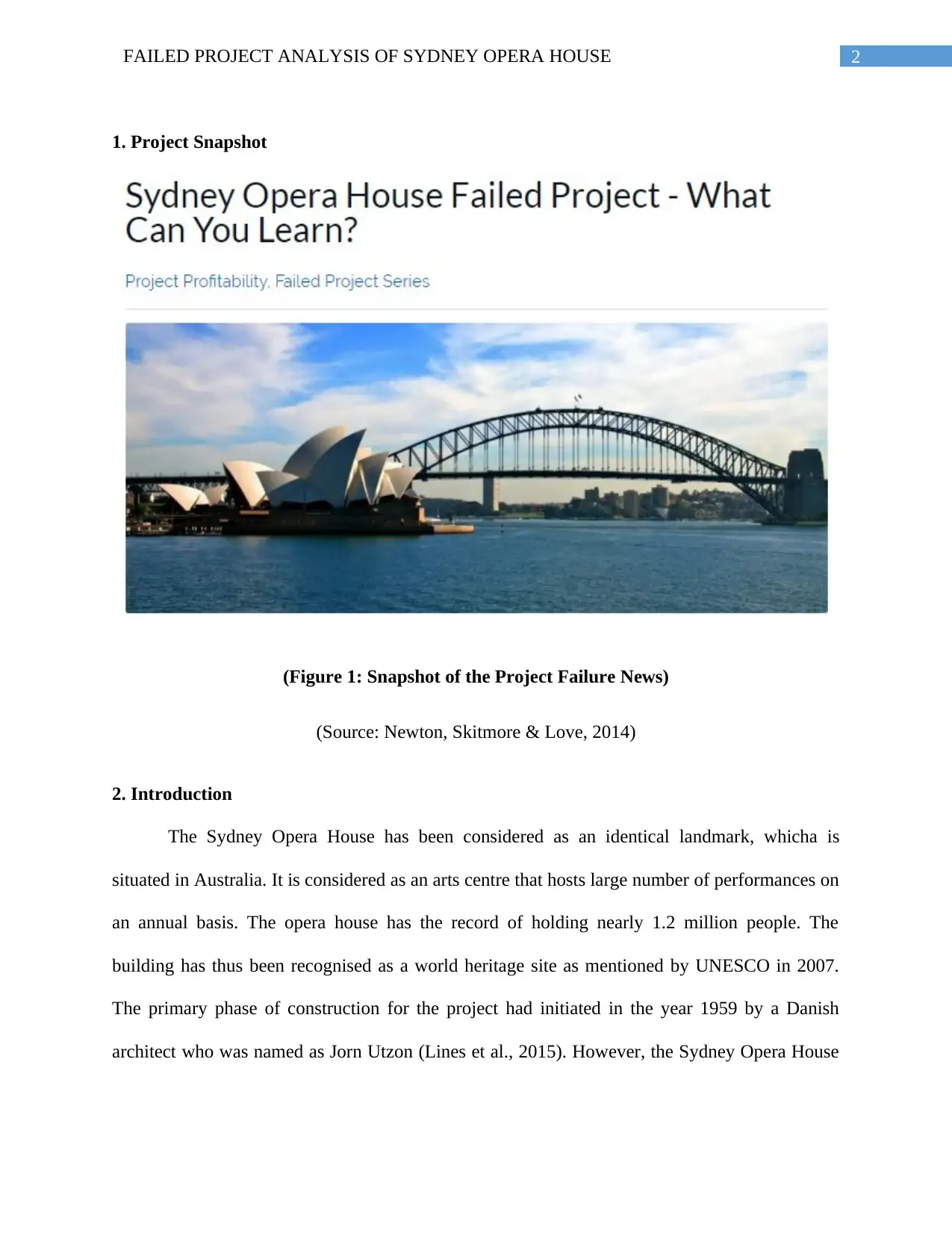
2FAILED PROJECT ANALYSIS OF SYDNEY OPERA HOUSE
1. Project Snapshot
(Figure 1: Snapshot of the Project Failure News)
(Source: Newton, Skitmore & Love, 2014)
2. Introduction
The Sydney Opera House has been considered as an identical landmark, whicha is
situated in Australia. It is considered as an arts centre that hosts large number of performances on
an annual basis. The opera house has the record of holding nearly 1.2 million people. The
building has thus been recognised as a world heritage site as mentioned by UNESCO in 2007.
The primary phase of construction for the project had initiated in the year 1959 by a Danish
architect who was named as Jorn Utzon (Lines et al., 2015). However, the Sydney Opera House
1. Project Snapshot
(Figure 1: Snapshot of the Project Failure News)
(Source: Newton, Skitmore & Love, 2014)
2. Introduction
The Sydney Opera House has been considered as an identical landmark, whicha is
situated in Australia. It is considered as an arts centre that hosts large number of performances on
an annual basis. The opera house has the record of holding nearly 1.2 million people. The
building has thus been recognised as a world heritage site as mentioned by UNESCO in 2007.
The primary phase of construction for the project had initiated in the year 1959 by a Danish
architect who was named as Jorn Utzon (Lines et al., 2015). However, the Sydney Opera House
⊘ This is a preview!⊘
Do you want full access?
Subscribe today to unlock all pages.

Trusted by 1+ million students worldwide
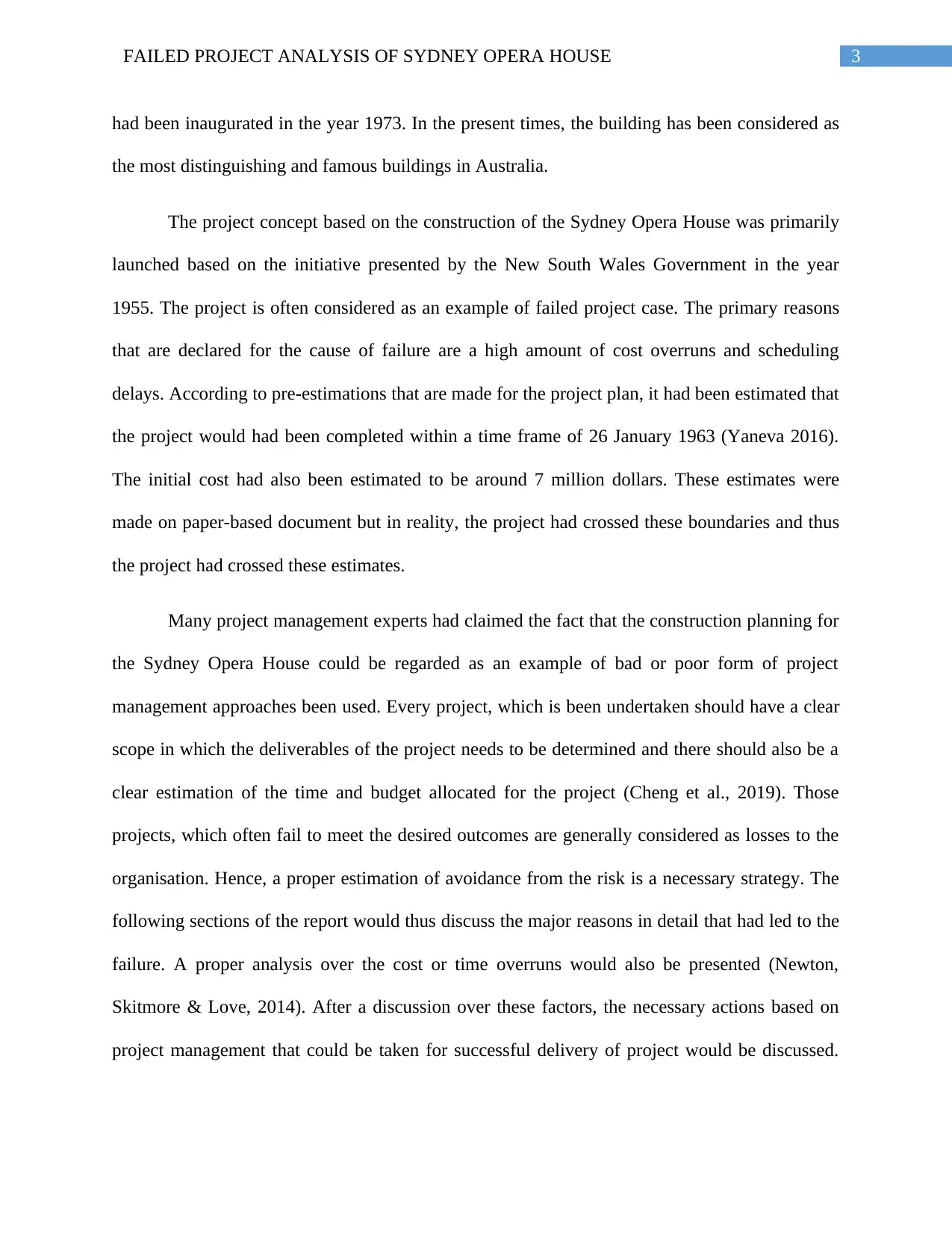
3FAILED PROJECT ANALYSIS OF SYDNEY OPERA HOUSE
had been inaugurated in the year 1973. In the present times, the building has been considered as
the most distinguishing and famous buildings in Australia.
The project concept based on the construction of the Sydney Opera House was primarily
launched based on the initiative presented by the New South Wales Government in the year
1955. The project is often considered as an example of failed project case. The primary reasons
that are declared for the cause of failure are a high amount of cost overruns and scheduling
delays. According to pre-estimations that are made for the project plan, it had been estimated that
the project would had been completed within a time frame of 26 January 1963 (Yaneva 2016).
The initial cost had also been estimated to be around 7 million dollars. These estimates were
made on paper-based document but in reality, the project had crossed these boundaries and thus
the project had crossed these estimates.
Many project management experts had claimed the fact that the construction planning for
the Sydney Opera House could be regarded as an example of bad or poor form of project
management approaches been used. Every project, which is been undertaken should have a clear
scope in which the deliverables of the project needs to be determined and there should also be a
clear estimation of the time and budget allocated for the project (Cheng et al., 2019). Those
projects, which often fail to meet the desired outcomes are generally considered as losses to the
organisation. Hence, a proper estimation of avoidance from the risk is a necessary strategy. The
following sections of the report would thus discuss the major reasons in detail that had led to the
failure. A proper analysis over the cost or time overruns would also be presented (Newton,
Skitmore & Love, 2014). After a discussion over these factors, the necessary actions based on
project management that could be taken for successful delivery of project would be discussed.
had been inaugurated in the year 1973. In the present times, the building has been considered as
the most distinguishing and famous buildings in Australia.
The project concept based on the construction of the Sydney Opera House was primarily
launched based on the initiative presented by the New South Wales Government in the year
1955. The project is often considered as an example of failed project case. The primary reasons
that are declared for the cause of failure are a high amount of cost overruns and scheduling
delays. According to pre-estimations that are made for the project plan, it had been estimated that
the project would had been completed within a time frame of 26 January 1963 (Yaneva 2016).
The initial cost had also been estimated to be around 7 million dollars. These estimates were
made on paper-based document but in reality, the project had crossed these boundaries and thus
the project had crossed these estimates.
Many project management experts had claimed the fact that the construction planning for
the Sydney Opera House could be regarded as an example of bad or poor form of project
management approaches been used. Every project, which is been undertaken should have a clear
scope in which the deliverables of the project needs to be determined and there should also be a
clear estimation of the time and budget allocated for the project (Cheng et al., 2019). Those
projects, which often fail to meet the desired outcomes are generally considered as losses to the
organisation. Hence, a proper estimation of avoidance from the risk is a necessary strategy. The
following sections of the report would thus discuss the major reasons in detail that had led to the
failure. A proper analysis over the cost or time overruns would also be presented (Newton,
Skitmore & Love, 2014). After a discussion over these factors, the necessary actions based on
project management that could be taken for successful delivery of project would be discussed.
Paraphrase This Document
Need a fresh take? Get an instant paraphrase of this document with our AI Paraphraser
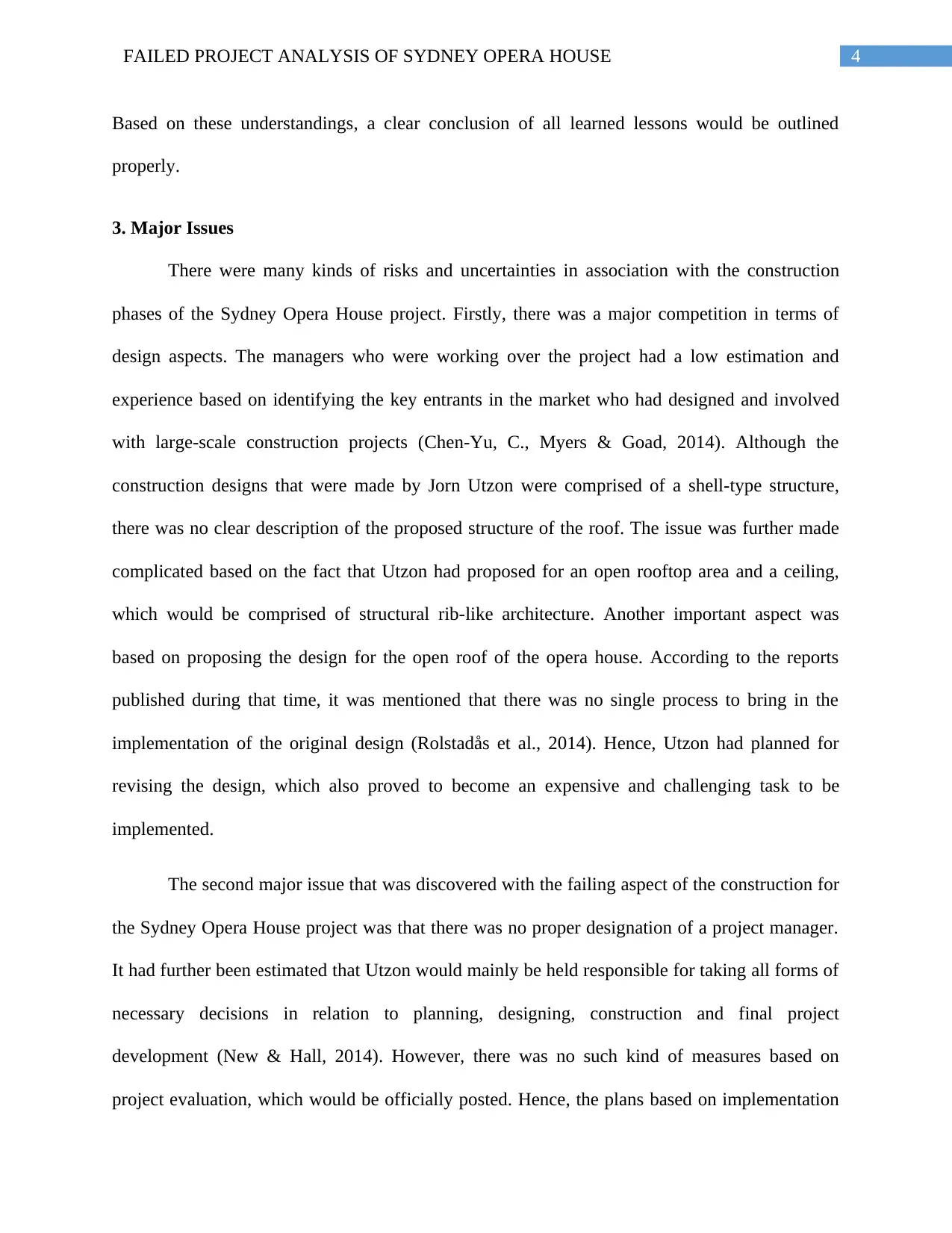
4FAILED PROJECT ANALYSIS OF SYDNEY OPERA HOUSE
Based on these understandings, a clear conclusion of all learned lessons would be outlined
properly.
3. Major Issues
There were many kinds of risks and uncertainties in association with the construction
phases of the Sydney Opera House project. Firstly, there was a major competition in terms of
design aspects. The managers who were working over the project had a low estimation and
experience based on identifying the key entrants in the market who had designed and involved
with large-scale construction projects (Chen-Yu, C., Myers & Goad, 2014). Although the
construction designs that were made by Jorn Utzon were comprised of a shell-type structure,
there was no clear description of the proposed structure of the roof. The issue was further made
complicated based on the fact that Utzon had proposed for an open rooftop area and a ceiling,
which would be comprised of structural rib-like architecture. Another important aspect was
based on proposing the design for the open roof of the opera house. According to the reports
published during that time, it was mentioned that there was no single process to bring in the
implementation of the original design (Rolstadås et al., 2014). Hence, Utzon had planned for
revising the design, which also proved to become an expensive and challenging task to be
implemented.
The second major issue that was discovered with the failing aspect of the construction for
the Sydney Opera House project was that there was no proper designation of a project manager.
It had further been estimated that Utzon would mainly be held responsible for taking all forms of
necessary decisions in relation to planning, designing, construction and final project
development (New & Hall, 2014). However, there was no such kind of measures based on
project evaluation, which would be officially posted. Hence, the plans based on implementation
Based on these understandings, a clear conclusion of all learned lessons would be outlined
properly.
3. Major Issues
There were many kinds of risks and uncertainties in association with the construction
phases of the Sydney Opera House project. Firstly, there was a major competition in terms of
design aspects. The managers who were working over the project had a low estimation and
experience based on identifying the key entrants in the market who had designed and involved
with large-scale construction projects (Chen-Yu, C., Myers & Goad, 2014). Although the
construction designs that were made by Jorn Utzon were comprised of a shell-type structure,
there was no clear description of the proposed structure of the roof. The issue was further made
complicated based on the fact that Utzon had proposed for an open rooftop area and a ceiling,
which would be comprised of structural rib-like architecture. Another important aspect was
based on proposing the design for the open roof of the opera house. According to the reports
published during that time, it was mentioned that there was no single process to bring in the
implementation of the original design (Rolstadås et al., 2014). Hence, Utzon had planned for
revising the design, which also proved to become an expensive and challenging task to be
implemented.
The second major issue that was discovered with the failing aspect of the construction for
the Sydney Opera House project was that there was no proper designation of a project manager.
It had further been estimated that Utzon would mainly be held responsible for taking all forms of
necessary decisions in relation to planning, designing, construction and final project
development (New & Hall, 2014). However, there was no such kind of measures based on
project evaluation, which would be officially posted. Hence, the plans based on implementation
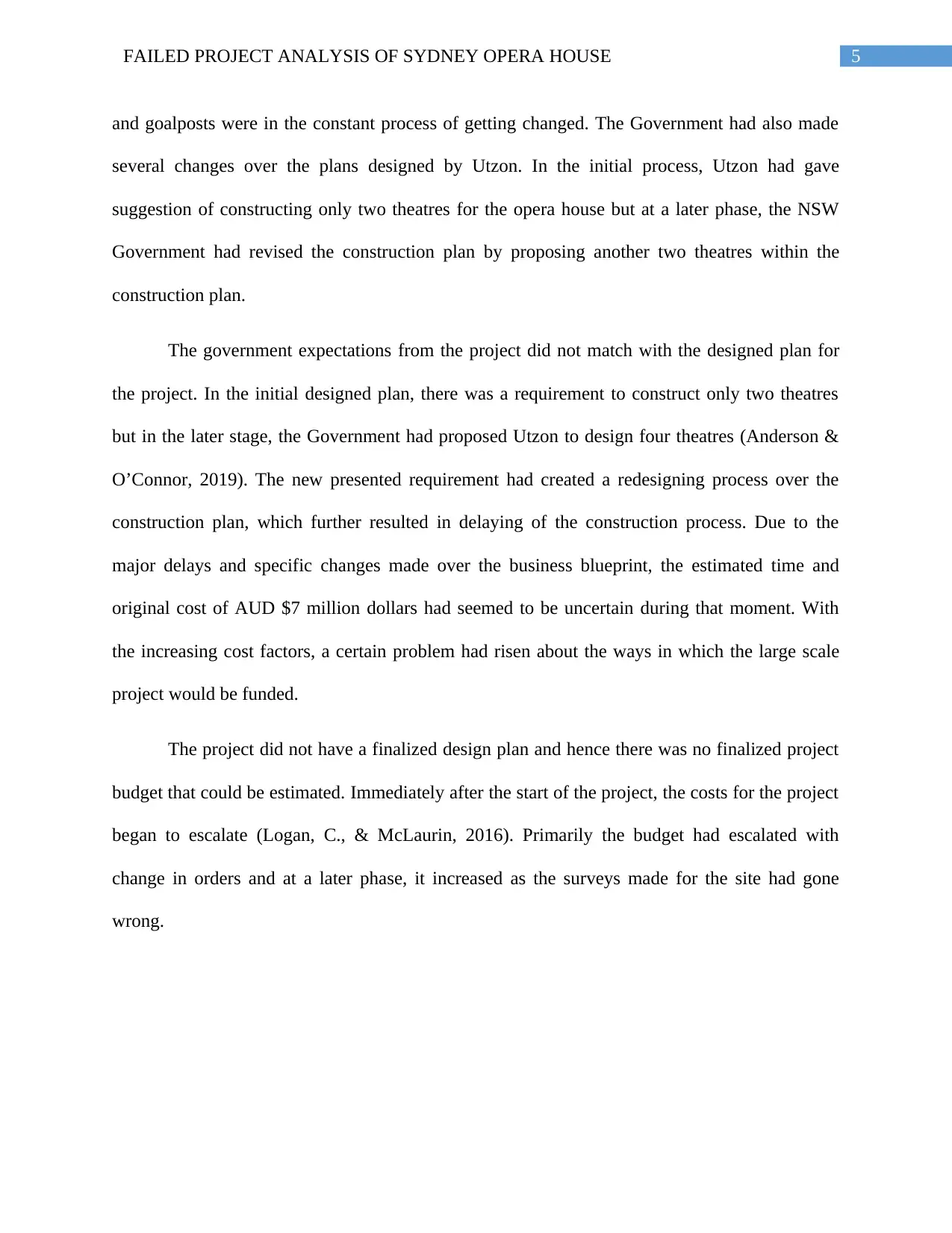
5FAILED PROJECT ANALYSIS OF SYDNEY OPERA HOUSE
and goalposts were in the constant process of getting changed. The Government had also made
several changes over the plans designed by Utzon. In the initial process, Utzon had gave
suggestion of constructing only two theatres for the opera house but at a later phase, the NSW
Government had revised the construction plan by proposing another two theatres within the
construction plan.
The government expectations from the project did not match with the designed plan for
the project. In the initial designed plan, there was a requirement to construct only two theatres
but in the later stage, the Government had proposed Utzon to design four theatres (Anderson &
O’Connor, 2019). The new presented requirement had created a redesigning process over the
construction plan, which further resulted in delaying of the construction process. Due to the
major delays and specific changes made over the business blueprint, the estimated time and
original cost of AUD $7 million dollars had seemed to be uncertain during that moment. With
the increasing cost factors, a certain problem had risen about the ways in which the large scale
project would be funded.
The project did not have a finalized design plan and hence there was no finalized project
budget that could be estimated. Immediately after the start of the project, the costs for the project
began to escalate (Logan, C., & McLaurin, 2016). Primarily the budget had escalated with
change in orders and at a later phase, it increased as the surveys made for the site had gone
wrong.
and goalposts were in the constant process of getting changed. The Government had also made
several changes over the plans designed by Utzon. In the initial process, Utzon had gave
suggestion of constructing only two theatres for the opera house but at a later phase, the NSW
Government had revised the construction plan by proposing another two theatres within the
construction plan.
The government expectations from the project did not match with the designed plan for
the project. In the initial designed plan, there was a requirement to construct only two theatres
but in the later stage, the Government had proposed Utzon to design four theatres (Anderson &
O’Connor, 2019). The new presented requirement had created a redesigning process over the
construction plan, which further resulted in delaying of the construction process. Due to the
major delays and specific changes made over the business blueprint, the estimated time and
original cost of AUD $7 million dollars had seemed to be uncertain during that moment. With
the increasing cost factors, a certain problem had risen about the ways in which the large scale
project would be funded.
The project did not have a finalized design plan and hence there was no finalized project
budget that could be estimated. Immediately after the start of the project, the costs for the project
began to escalate (Logan, C., & McLaurin, 2016). Primarily the budget had escalated with
change in orders and at a later phase, it increased as the surveys made for the site had gone
wrong.
⊘ This is a preview!⊘
Do you want full access?
Subscribe today to unlock all pages.

Trusted by 1+ million students worldwide
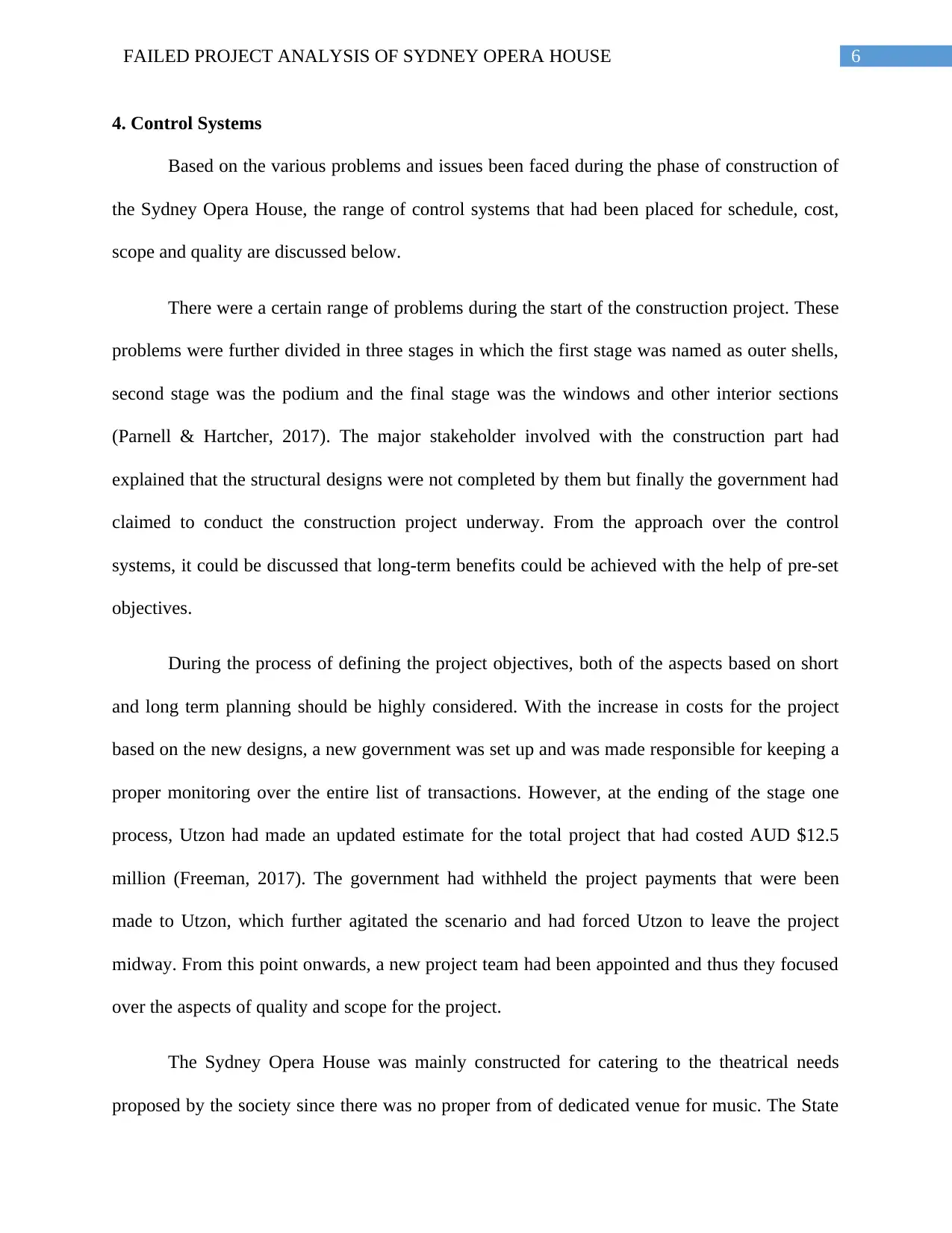
6FAILED PROJECT ANALYSIS OF SYDNEY OPERA HOUSE
4. Control Systems
Based on the various problems and issues been faced during the phase of construction of
the Sydney Opera House, the range of control systems that had been placed for schedule, cost,
scope and quality are discussed below.
There were a certain range of problems during the start of the construction project. These
problems were further divided in three stages in which the first stage was named as outer shells,
second stage was the podium and the final stage was the windows and other interior sections
(Parnell & Hartcher, 2017). The major stakeholder involved with the construction part had
explained that the structural designs were not completed by them but finally the government had
claimed to conduct the construction project underway. From the approach over the control
systems, it could be discussed that long-term benefits could be achieved with the help of pre-set
objectives.
During the process of defining the project objectives, both of the aspects based on short
and long term planning should be highly considered. With the increase in costs for the project
based on the new designs, a new government was set up and was made responsible for keeping a
proper monitoring over the entire list of transactions. However, at the ending of the stage one
process, Utzon had made an updated estimate for the total project that had costed AUD $12.5
million (Freeman, 2017). The government had withheld the project payments that were been
made to Utzon, which further agitated the scenario and had forced Utzon to leave the project
midway. From this point onwards, a new project team had been appointed and thus they focused
over the aspects of quality and scope for the project.
The Sydney Opera House was mainly constructed for catering to the theatrical needs
proposed by the society since there was no proper from of dedicated venue for music. The State
4. Control Systems
Based on the various problems and issues been faced during the phase of construction of
the Sydney Opera House, the range of control systems that had been placed for schedule, cost,
scope and quality are discussed below.
There were a certain range of problems during the start of the construction project. These
problems were further divided in three stages in which the first stage was named as outer shells,
second stage was the podium and the final stage was the windows and other interior sections
(Parnell & Hartcher, 2017). The major stakeholder involved with the construction part had
explained that the structural designs were not completed by them but finally the government had
claimed to conduct the construction project underway. From the approach over the control
systems, it could be discussed that long-term benefits could be achieved with the help of pre-set
objectives.
During the process of defining the project objectives, both of the aspects based on short
and long term planning should be highly considered. With the increase in costs for the project
based on the new designs, a new government was set up and was made responsible for keeping a
proper monitoring over the entire list of transactions. However, at the ending of the stage one
process, Utzon had made an updated estimate for the total project that had costed AUD $12.5
million (Freeman, 2017). The government had withheld the project payments that were been
made to Utzon, which further agitated the scenario and had forced Utzon to leave the project
midway. From this point onwards, a new project team had been appointed and thus they focused
over the aspects of quality and scope for the project.
The Sydney Opera House was mainly constructed for catering to the theatrical needs
proposed by the society since there was no proper from of dedicated venue for music. The State
Paraphrase This Document
Need a fresh take? Get an instant paraphrase of this document with our AI Paraphraser
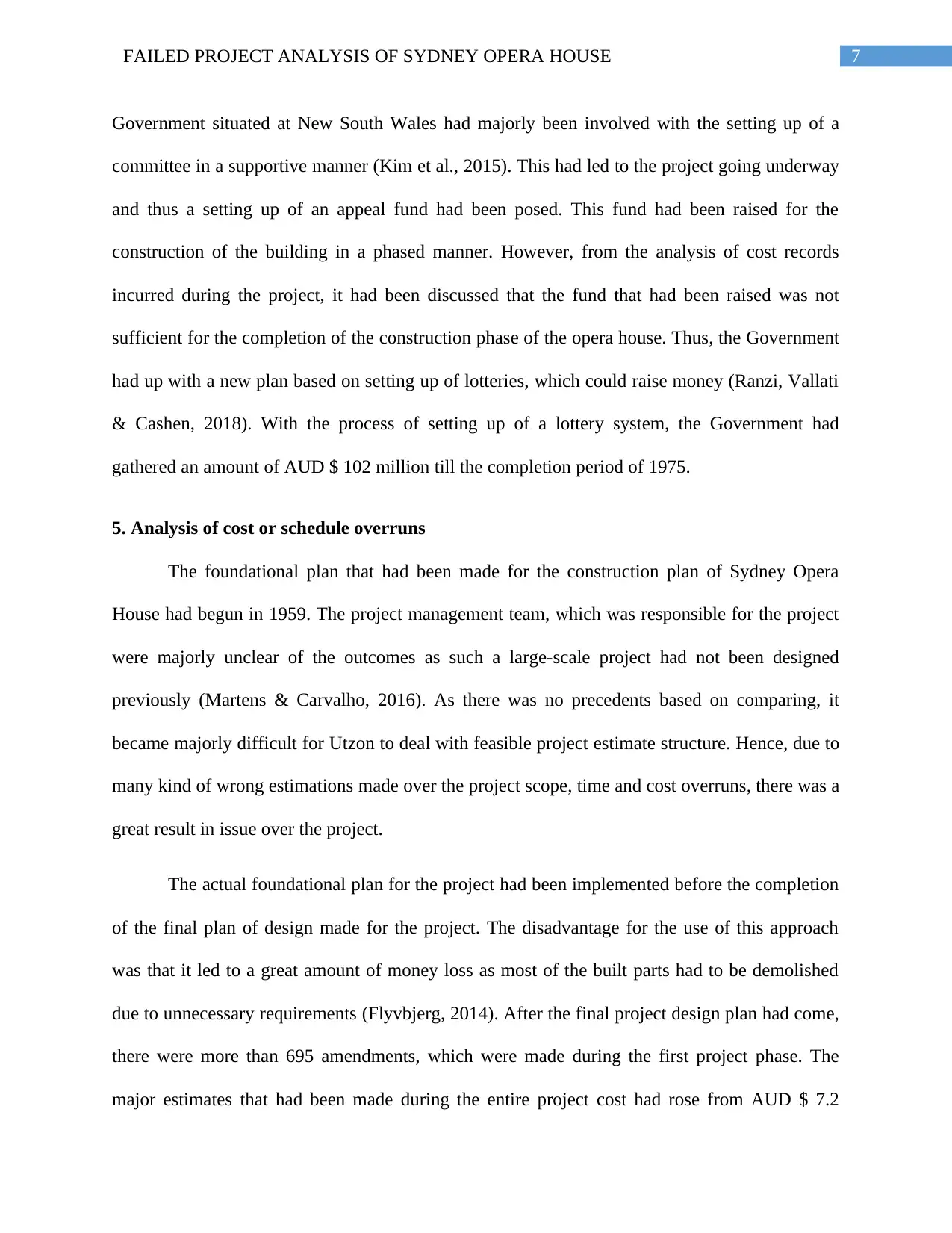
7FAILED PROJECT ANALYSIS OF SYDNEY OPERA HOUSE
Government situated at New South Wales had majorly been involved with the setting up of a
committee in a supportive manner (Kim et al., 2015). This had led to the project going underway
and thus a setting up of an appeal fund had been posed. This fund had been raised for the
construction of the building in a phased manner. However, from the analysis of cost records
incurred during the project, it had been discussed that the fund that had been raised was not
sufficient for the completion of the construction phase of the opera house. Thus, the Government
had up with a new plan based on setting up of lotteries, which could raise money (Ranzi, Vallati
& Cashen, 2018). With the process of setting up of a lottery system, the Government had
gathered an amount of AUD $ 102 million till the completion period of 1975.
5. Analysis of cost or schedule overruns
The foundational plan that had been made for the construction plan of Sydney Opera
House had begun in 1959. The project management team, which was responsible for the project
were majorly unclear of the outcomes as such a large-scale project had not been designed
previously (Martens & Carvalho, 2016). As there was no precedents based on comparing, it
became majorly difficult for Utzon to deal with feasible project estimate structure. Hence, due to
many kind of wrong estimations made over the project scope, time and cost overruns, there was a
great result in issue over the project.
The actual foundational plan for the project had been implemented before the completion
of the final plan of design made for the project. The disadvantage for the use of this approach
was that it led to a great amount of money loss as most of the built parts had to be demolished
due to unnecessary requirements (Flyvbjerg, 2014). After the final project design plan had come,
there were more than 695 amendments, which were made during the first project phase. The
major estimates that had been made during the entire project cost had rose from AUD $ 7.2
Government situated at New South Wales had majorly been involved with the setting up of a
committee in a supportive manner (Kim et al., 2015). This had led to the project going underway
and thus a setting up of an appeal fund had been posed. This fund had been raised for the
construction of the building in a phased manner. However, from the analysis of cost records
incurred during the project, it had been discussed that the fund that had been raised was not
sufficient for the completion of the construction phase of the opera house. Thus, the Government
had up with a new plan based on setting up of lotteries, which could raise money (Ranzi, Vallati
& Cashen, 2018). With the process of setting up of a lottery system, the Government had
gathered an amount of AUD $ 102 million till the completion period of 1975.
5. Analysis of cost or schedule overruns
The foundational plan that had been made for the construction plan of Sydney Opera
House had begun in 1959. The project management team, which was responsible for the project
were majorly unclear of the outcomes as such a large-scale project had not been designed
previously (Martens & Carvalho, 2016). As there was no precedents based on comparing, it
became majorly difficult for Utzon to deal with feasible project estimate structure. Hence, due to
many kind of wrong estimations made over the project scope, time and cost overruns, there was a
great result in issue over the project.
The actual foundational plan for the project had been implemented before the completion
of the final plan of design made for the project. The disadvantage for the use of this approach
was that it led to a great amount of money loss as most of the built parts had to be demolished
due to unnecessary requirements (Flyvbjerg, 2014). After the final project design plan had come,
there were more than 695 amendments, which were made during the first project phase. The
major estimates that had been made during the entire project cost had rose from AUD $ 7.2
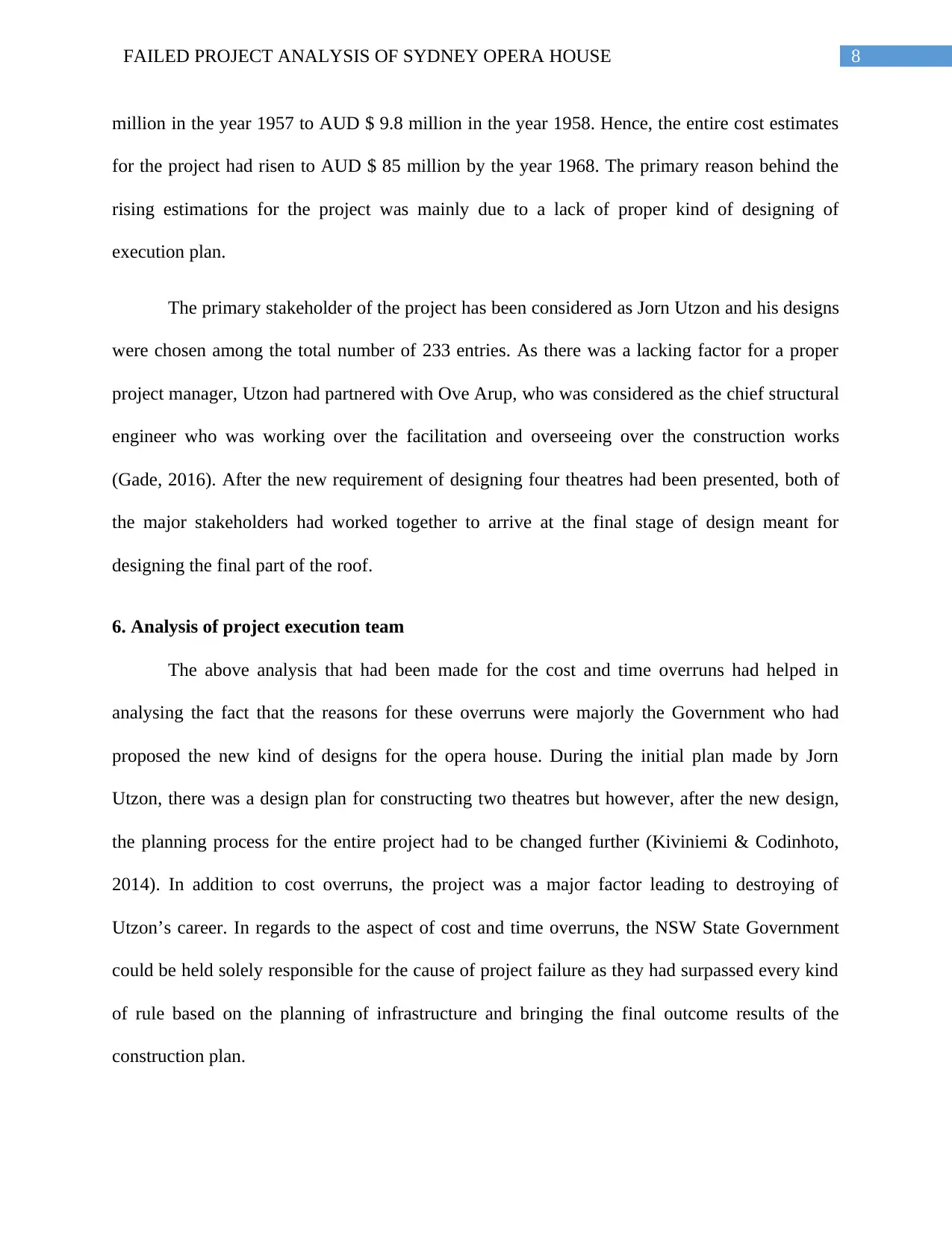
8FAILED PROJECT ANALYSIS OF SYDNEY OPERA HOUSE
million in the year 1957 to AUD $ 9.8 million in the year 1958. Hence, the entire cost estimates
for the project had risen to AUD $ 85 million by the year 1968. The primary reason behind the
rising estimations for the project was mainly due to a lack of proper kind of designing of
execution plan.
The primary stakeholder of the project has been considered as Jorn Utzon and his designs
were chosen among the total number of 233 entries. As there was a lacking factor for a proper
project manager, Utzon had partnered with Ove Arup, who was considered as the chief structural
engineer who was working over the facilitation and overseeing over the construction works
(Gade, 2016). After the new requirement of designing four theatres had been presented, both of
the major stakeholders had worked together to arrive at the final stage of design meant for
designing the final part of the roof.
6. Analysis of project execution team
The above analysis that had been made for the cost and time overruns had helped in
analysing the fact that the reasons for these overruns were majorly the Government who had
proposed the new kind of designs for the opera house. During the initial plan made by Jorn
Utzon, there was a design plan for constructing two theatres but however, after the new design,
the planning process for the entire project had to be changed further (Kiviniemi & Codinhoto,
2014). In addition to cost overruns, the project was a major factor leading to destroying of
Utzon’s career. In regards to the aspect of cost and time overruns, the NSW State Government
could be held solely responsible for the cause of project failure as they had surpassed every kind
of rule based on the planning of infrastructure and bringing the final outcome results of the
construction plan.
million in the year 1957 to AUD $ 9.8 million in the year 1958. Hence, the entire cost estimates
for the project had risen to AUD $ 85 million by the year 1968. The primary reason behind the
rising estimations for the project was mainly due to a lack of proper kind of designing of
execution plan.
The primary stakeholder of the project has been considered as Jorn Utzon and his designs
were chosen among the total number of 233 entries. As there was a lacking factor for a proper
project manager, Utzon had partnered with Ove Arup, who was considered as the chief structural
engineer who was working over the facilitation and overseeing over the construction works
(Gade, 2016). After the new requirement of designing four theatres had been presented, both of
the major stakeholders had worked together to arrive at the final stage of design meant for
designing the final part of the roof.
6. Analysis of project execution team
The above analysis that had been made for the cost and time overruns had helped in
analysing the fact that the reasons for these overruns were majorly the Government who had
proposed the new kind of designs for the opera house. During the initial plan made by Jorn
Utzon, there was a design plan for constructing two theatres but however, after the new design,
the planning process for the entire project had to be changed further (Kiviniemi & Codinhoto,
2014). In addition to cost overruns, the project was a major factor leading to destroying of
Utzon’s career. In regards to the aspect of cost and time overruns, the NSW State Government
could be held solely responsible for the cause of project failure as they had surpassed every kind
of rule based on the planning of infrastructure and bringing the final outcome results of the
construction plan.
⊘ This is a preview!⊘
Do you want full access?
Subscribe today to unlock all pages.

Trusted by 1+ million students worldwide
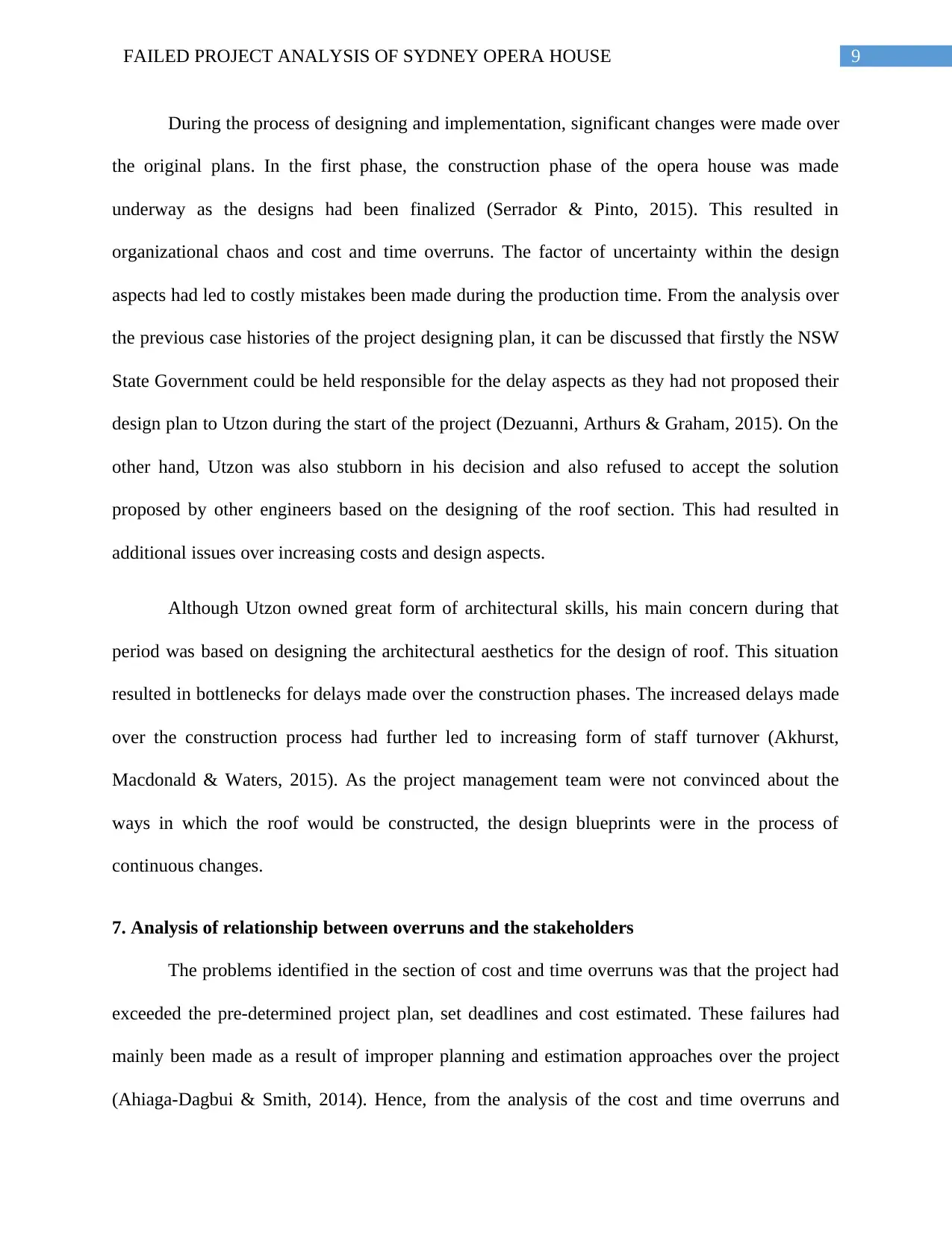
9FAILED PROJECT ANALYSIS OF SYDNEY OPERA HOUSE
During the process of designing and implementation, significant changes were made over
the original plans. In the first phase, the construction phase of the opera house was made
underway as the designs had been finalized (Serrador & Pinto, 2015). This resulted in
organizational chaos and cost and time overruns. The factor of uncertainty within the design
aspects had led to costly mistakes been made during the production time. From the analysis over
the previous case histories of the project designing plan, it can be discussed that firstly the NSW
State Government could be held responsible for the delay aspects as they had not proposed their
design plan to Utzon during the start of the project (Dezuanni, Arthurs & Graham, 2015). On the
other hand, Utzon was also stubborn in his decision and also refused to accept the solution
proposed by other engineers based on the designing of the roof section. This had resulted in
additional issues over increasing costs and design aspects.
Although Utzon owned great form of architectural skills, his main concern during that
period was based on designing the architectural aesthetics for the design of roof. This situation
resulted in bottlenecks for delays made over the construction phases. The increased delays made
over the construction process had further led to increasing form of staff turnover (Akhurst,
Macdonald & Waters, 2015). As the project management team were not convinced about the
ways in which the roof would be constructed, the design blueprints were in the process of
continuous changes.
7. Analysis of relationship between overruns and the stakeholders
The problems identified in the section of cost and time overruns was that the project had
exceeded the pre-determined project plan, set deadlines and cost estimated. These failures had
mainly been made as a result of improper planning and estimation approaches over the project
(Ahiaga-Dagbui & Smith, 2014). Hence, from the analysis of the cost and time overruns and
During the process of designing and implementation, significant changes were made over
the original plans. In the first phase, the construction phase of the opera house was made
underway as the designs had been finalized (Serrador & Pinto, 2015). This resulted in
organizational chaos and cost and time overruns. The factor of uncertainty within the design
aspects had led to costly mistakes been made during the production time. From the analysis over
the previous case histories of the project designing plan, it can be discussed that firstly the NSW
State Government could be held responsible for the delay aspects as they had not proposed their
design plan to Utzon during the start of the project (Dezuanni, Arthurs & Graham, 2015). On the
other hand, Utzon was also stubborn in his decision and also refused to accept the solution
proposed by other engineers based on the designing of the roof section. This had resulted in
additional issues over increasing costs and design aspects.
Although Utzon owned great form of architectural skills, his main concern during that
period was based on designing the architectural aesthetics for the design of roof. This situation
resulted in bottlenecks for delays made over the construction phases. The increased delays made
over the construction process had further led to increasing form of staff turnover (Akhurst,
Macdonald & Waters, 2015). As the project management team were not convinced about the
ways in which the roof would be constructed, the design blueprints were in the process of
continuous changes.
7. Analysis of relationship between overruns and the stakeholders
The problems identified in the section of cost and time overruns was that the project had
exceeded the pre-determined project plan, set deadlines and cost estimated. These failures had
mainly been made as a result of improper planning and estimation approaches over the project
(Ahiaga-Dagbui & Smith, 2014). Hence, from the analysis of the cost and time overruns and
Paraphrase This Document
Need a fresh take? Get an instant paraphrase of this document with our AI Paraphraser
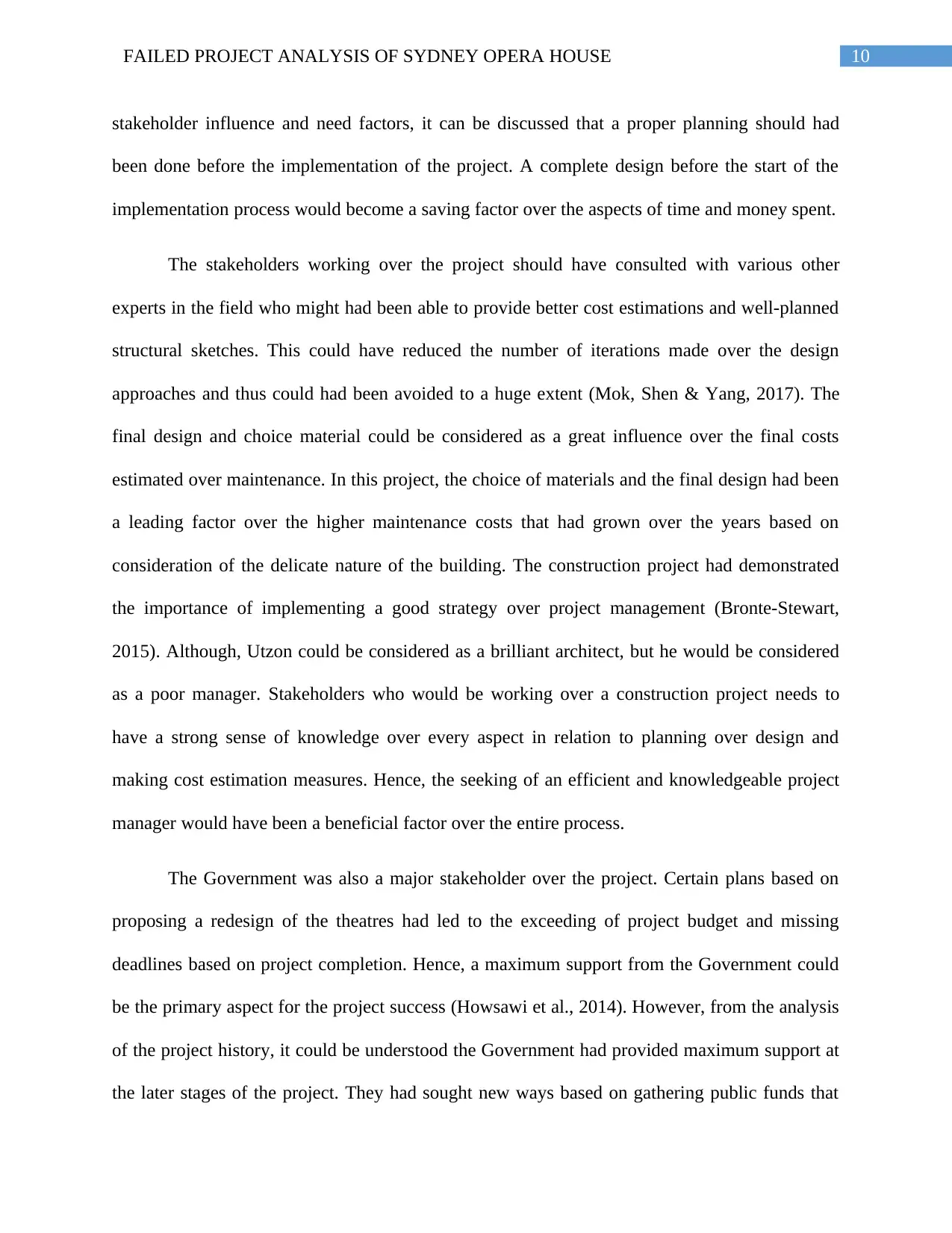
10FAILED PROJECT ANALYSIS OF SYDNEY OPERA HOUSE
stakeholder influence and need factors, it can be discussed that a proper planning should had
been done before the implementation of the project. A complete design before the start of the
implementation process would become a saving factor over the aspects of time and money spent.
The stakeholders working over the project should have consulted with various other
experts in the field who might had been able to provide better cost estimations and well-planned
structural sketches. This could have reduced the number of iterations made over the design
approaches and thus could had been avoided to a huge extent (Mok, Shen & Yang, 2017). The
final design and choice material could be considered as a great influence over the final costs
estimated over maintenance. In this project, the choice of materials and the final design had been
a leading factor over the higher maintenance costs that had grown over the years based on
consideration of the delicate nature of the building. The construction project had demonstrated
the importance of implementing a good strategy over project management (Bronte-Stewart,
2015). Although, Utzon could be considered as a brilliant architect, but he would be considered
as a poor manager. Stakeholders who would be working over a construction project needs to
have a strong sense of knowledge over every aspect in relation to planning over design and
making cost estimation measures. Hence, the seeking of an efficient and knowledgeable project
manager would have been a beneficial factor over the entire process.
The Government was also a major stakeholder over the project. Certain plans based on
proposing a redesign of the theatres had led to the exceeding of project budget and missing
deadlines based on project completion. Hence, a maximum support from the Government could
be the primary aspect for the project success (Howsawi et al., 2014). However, from the analysis
of the project history, it could be understood the Government had provided maximum support at
the later stages of the project. They had sought new ways based on gathering public funds that
stakeholder influence and need factors, it can be discussed that a proper planning should had
been done before the implementation of the project. A complete design before the start of the
implementation process would become a saving factor over the aspects of time and money spent.
The stakeholders working over the project should have consulted with various other
experts in the field who might had been able to provide better cost estimations and well-planned
structural sketches. This could have reduced the number of iterations made over the design
approaches and thus could had been avoided to a huge extent (Mok, Shen & Yang, 2017). The
final design and choice material could be considered as a great influence over the final costs
estimated over maintenance. In this project, the choice of materials and the final design had been
a leading factor over the higher maintenance costs that had grown over the years based on
consideration of the delicate nature of the building. The construction project had demonstrated
the importance of implementing a good strategy over project management (Bronte-Stewart,
2015). Although, Utzon could be considered as a brilliant architect, but he would be considered
as a poor manager. Stakeholders who would be working over a construction project needs to
have a strong sense of knowledge over every aspect in relation to planning over design and
making cost estimation measures. Hence, the seeking of an efficient and knowledgeable project
manager would have been a beneficial factor over the entire process.
The Government was also a major stakeholder over the project. Certain plans based on
proposing a redesign of the theatres had led to the exceeding of project budget and missing
deadlines based on project completion. Hence, a maximum support from the Government could
be the primary aspect for the project success (Howsawi et al., 2014). However, from the analysis
of the project history, it could be understood the Government had provided maximum support at
the later stages of the project. They had sought new ways based on gathering public funds that
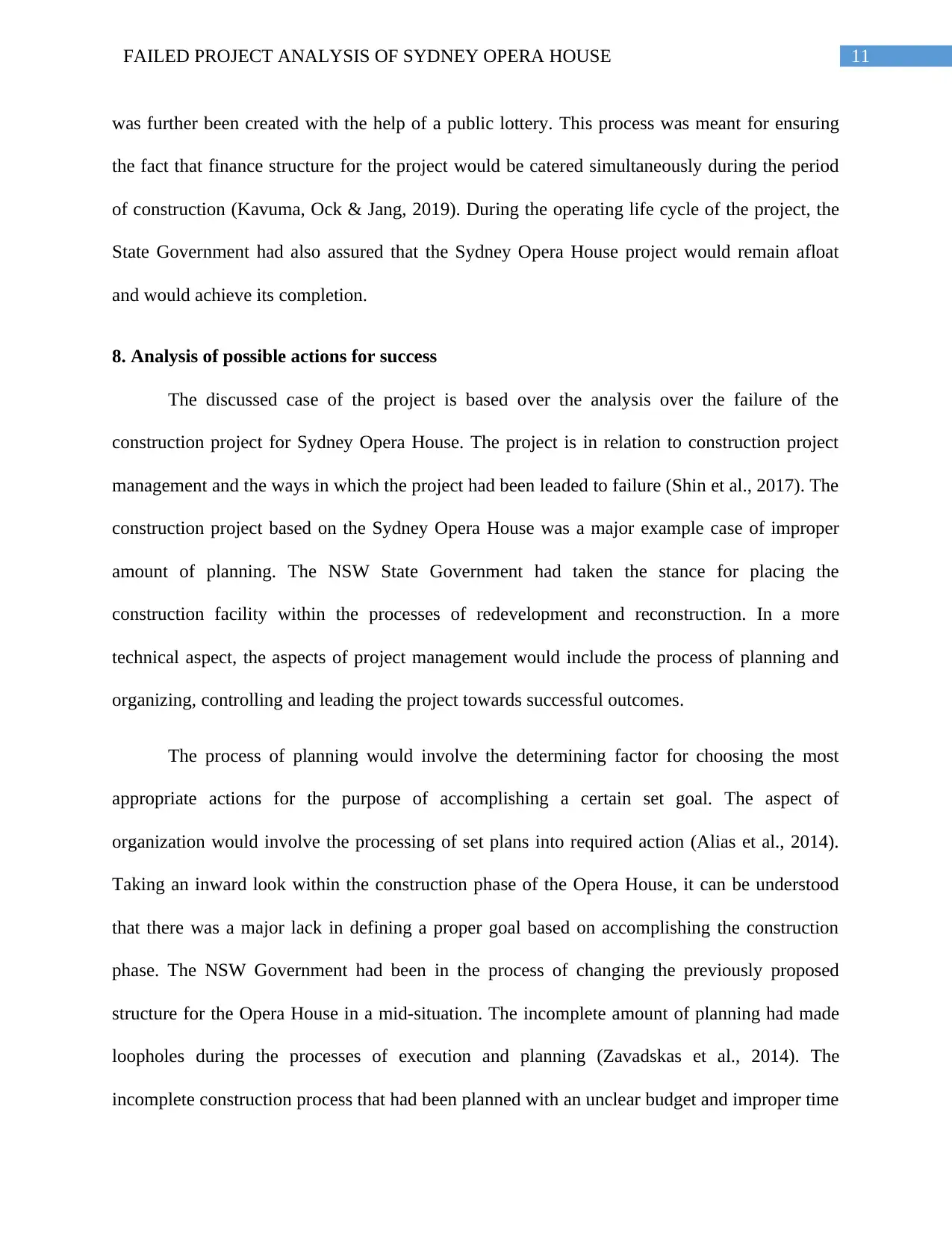
11FAILED PROJECT ANALYSIS OF SYDNEY OPERA HOUSE
was further been created with the help of a public lottery. This process was meant for ensuring
the fact that finance structure for the project would be catered simultaneously during the period
of construction (Kavuma, Ock & Jang, 2019). During the operating life cycle of the project, the
State Government had also assured that the Sydney Opera House project would remain afloat
and would achieve its completion.
8. Analysis of possible actions for success
The discussed case of the project is based over the analysis over the failure of the
construction project for Sydney Opera House. The project is in relation to construction project
management and the ways in which the project had been leaded to failure (Shin et al., 2017). The
construction project based on the Sydney Opera House was a major example case of improper
amount of planning. The NSW State Government had taken the stance for placing the
construction facility within the processes of redevelopment and reconstruction. In a more
technical aspect, the aspects of project management would include the process of planning and
organizing, controlling and leading the project towards successful outcomes.
The process of planning would involve the determining factor for choosing the most
appropriate actions for the purpose of accomplishing a certain set goal. The aspect of
organization would involve the processing of set plans into required action (Alias et al., 2014).
Taking an inward look within the construction phase of the Opera House, it can be understood
that there was a major lack in defining a proper goal based on accomplishing the construction
phase. The NSW Government had been in the process of changing the previously proposed
structure for the Opera House in a mid-situation. The incomplete amount of planning had made
loopholes during the processes of execution and planning (Zavadskas et al., 2014). The
incomplete construction process that had been planned with an unclear budget and improper time
was further been created with the help of a public lottery. This process was meant for ensuring
the fact that finance structure for the project would be catered simultaneously during the period
of construction (Kavuma, Ock & Jang, 2019). During the operating life cycle of the project, the
State Government had also assured that the Sydney Opera House project would remain afloat
and would achieve its completion.
8. Analysis of possible actions for success
The discussed case of the project is based over the analysis over the failure of the
construction project for Sydney Opera House. The project is in relation to construction project
management and the ways in which the project had been leaded to failure (Shin et al., 2017). The
construction project based on the Sydney Opera House was a major example case of improper
amount of planning. The NSW State Government had taken the stance for placing the
construction facility within the processes of redevelopment and reconstruction. In a more
technical aspect, the aspects of project management would include the process of planning and
organizing, controlling and leading the project towards successful outcomes.
The process of planning would involve the determining factor for choosing the most
appropriate actions for the purpose of accomplishing a certain set goal. The aspect of
organization would involve the processing of set plans into required action (Alias et al., 2014).
Taking an inward look within the construction phase of the Opera House, it can be understood
that there was a major lack in defining a proper goal based on accomplishing the construction
phase. The NSW Government had been in the process of changing the previously proposed
structure for the Opera House in a mid-situation. The incomplete amount of planning had made
loopholes during the processes of execution and planning (Zavadskas et al., 2014). The
incomplete construction process that had been planned with an unclear budget and improper time
⊘ This is a preview!⊘
Do you want full access?
Subscribe today to unlock all pages.

Trusted by 1+ million students worldwide
1 out of 21
Related Documents
Your All-in-One AI-Powered Toolkit for Academic Success.
+13062052269
info@desklib.com
Available 24*7 on WhatsApp / Email
![[object Object]](/_next/static/media/star-bottom.7253800d.svg)
Unlock your academic potential
Copyright © 2020–2025 A2Z Services. All Rights Reserved. Developed and managed by ZUCOL.





